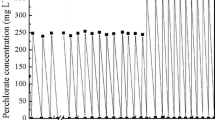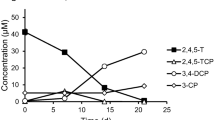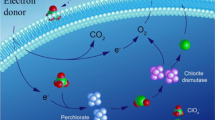Summary
A mixed bacterial culture capable of reducing perchlorate stoichiometrically to chloride under naerobic conditions was enriched from municipal digester sludge. The reduction of 10 mM perchlorate resulted in oxidation of the medium and cessation of perchlorate reduction. The activity was recovered on addition of a reducing agent. Addition of air to the culture during perchlorate reduction immediately terminated the process and aeration for 12 h permanently destroyed the ability of the culture to reduce perchlorate. The culture also reduced nitrite, nitrate, chlorite, chlorate and sulfate. The presence of 10 mM nitrite or chlorite completely inhibited perchlorate reduction, whereas the same concentration of chlorate decreased the reduction rate. Nitrate or sulfate did not affect perchlorate reduction. Chlorate and chlorite, suspected intermediates in the reduction of perchlorate to chloride, were not detected in any cultures during reduction of perchlorate.
Similar content being viewed by others
References
Hackenthal, E. 1965. Die reduktion von perchlorat durch bakterien — II. Die identität der nitratreduktase und des perchlorat reduzierenden enzyms ausB. cereus. Biochem. Pharm. 14: 1313–1324.
Hackenthal, E., W. Mannheim, R. Hackenthal and R. Becher. 1964. Die reduktion von perchlorat durch bakterien. I. Untersuchungen an intakten zellen. Biochem. Pharm. 13: 195–106.
Jacob, H.-E. 1970. Redox potential. In: Methods in Microbiology vol. 2 (Norris, J.R. and D.W. Ribbons, ed.), pp. 91–123, Academic Press, Inc., New York.
Jenneman, G.E., M.J. McInerney and R. Knapp. 1986. Effect of nitrate on biogenic sulfide production. Appl. Environ. Microbiol. 51: 1205–1211.
Jenneman, G.E., A.D. Montgomery and M.J. McInerney. 1986. Method for detection of microorganisms that produce gaseous nitrogen oxides. Appl. Environ. Microbiol. 51: 776–780.
Korenkov, V.N., V.I. Romanenko, S.I. Kuznetsov and J.V. Voronov. 1976. Process for purification of industrial waste waters from perchlorates and chlorates. US Patent 3 943 055.
Malmqvist, A., T. Welander and L. Gunnarsson. 1991. Anaerobic growth of microorganisms with chlorate as an electron acceptor. Appl. Environ. Microbiol. 57: 2229–2232.
McEwan, A.G., H.G. Wetzstein, O. Meyer, J.B. Jackson and S.J. Ferguson. 1987. The periplasmic nitrate reductase ofRhodobacter capsulatus; purification, characterization, and distinction from a single reductase for trimethylamine-N-oxide, dimethylsulphoxide and chlorate. Arch. Microbiol. 147: 340–345.
Oltmann, L.F., V.P. Claassen, P. Kastelein, W.N.M. Reijnders and A.H. Stouthamer. 1979. Influence of Tungstate on the formation and activities of four reductases inProteus mirabilis. FEBS Lett. 106: 43–46.
Oltmann, L.F., W.N.M. Reijnders and A.H. Stouthamer. 1976. Characterization of a purified nitrate reductase A and chlorate reductase C fromProteus mirabilis. Arch. Microbiol. 111: 25–35.
Payne, W.J. 1973. Reduction of nitrogenous oxides by microorganisms. Bact. Rev. 37: 409–452.
Payne, W. J. 1981. Denitrification, pp. 109–111, John Wiley and Sons, New York.
Pichinoty, F., J. Puig, M. Chippaux, J. Bigliardi-Rouvier and J. Gendre. 1969. Recherches sur des mutants bacteriens ayant perdu les activites catalytiques liees a la nitrate-reductase A. Ann. Inst. Pasteur 116: 409–432.
Romanenko, V.I., V.N. Korenkov and S.I. Kuznetsov. 1976. Bacterial decomposition of ammonium perchlorate. Mikrobiologiya 45: 204–209.
Riggs, D.L., J.S. Tang and E.L. Barrett. 1987. Thiosulfate reductase as a chlorate reductase inSalmonella typhimurium. FEMS Microbiol. Lett. 44: 427–430.
Sanchez Crispin, J.A., M. Dubourdieu and J. Puig. 1984. Chlorate metabolism by whole cells and vesicles ofEsherichia coli K-12. Acta Cientifica Venezolana 35: 363–368.
Stouthamer, A.H. 1967a. Nitrate reduction inAerobacter aerogenes. I. Isolation and properties of mutant strains blocked in nitrate assimilation and resistant against chlorate. Arch. Mikrobiol. 56: 68–75.
Stouthamer, A.H. 1967b. Nitrate reduction inAerobacter aerogenes. II. Characterization of mutants blocked in the reduction of nitrate and chlorate. Arch. Mikrobiol. 56: 76–80.
Urbanski, T. 1988. Chemistry and Technology of Explosives, vol. 4, pp. 602–620, Pergamon Press, New York.
Author information
Authors and Affiliations
Rights and permissions
About this article
Cite this article
Attaway, H., Smith, M. Reduction of perchlorate by an anaerobic enrichment culture. Journal of Industrial Microbiology 12, 408–412 (1993). https://doi.org/10.1007/BF01569673
Received:
Revised:
Accepted:
Issue Date:
DOI: https://doi.org/10.1007/BF01569673




